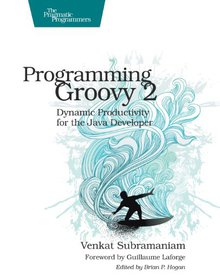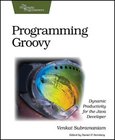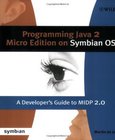Programming Groovy 2
Dynamic Productivity for the Java Developer

Book Details:
| Publisher: | Pragmatic Bookshelf |
| Series: | Pragmatic Bookshelf |
| Author: | Venkat Subramaniam |
| Edition: | 1 |
| ISBN-10: | 1937785300 |
| ISBN-13: | 9781937785307 |
| Pages: | 350 |
| Published: | Jul 22 2013 |
| Posted: | Nov 19 2014 |
| Language: | English |
| Book format: | |
| Book size: | 2.01 MB |
Book Description:
Groovy brings you the best of both worlds: a flexible, highly productive, agile, dynamic language that runs on the rich framework of the Java Platform. Groovy preserves the Java semantics and extends the JDK to give you true dynamic language capabilities. Programming Groovy 2 will help you, the experienced Java developer, learn and take advantage of the latest version of this rich dynamic language. You'll go from the basics of Groovy to the latest advances in the language, including options for type checking, tail-call and memoization optimizations, compile time metaprogramming, and fluent interfaces to create DSLs. You don't have to leave the rich Java Platform to take advantage of Groovy. Groovy preserves Java's semantics and extends the JDK, so programming in Groovy feels like the Java language has been augmented; it's like working with a lighter, more elegant Java. If you're an experienced Java developer who wants to learn how Groovy works, you'll find exactly what you need in this book. You'll start with the fundamentals of programming in Groovy and how it works with Java, and then you'll explore advanced concepts such as unit testing with mock objects, using Builders, working with databases and XML, and creating DSLs. You'll master Groovy's powerful yet complex run-time and compile-time metaprogramming features. Much has evolved in the Groovy language since the publication of the first edition of Programming Groovy. Programming Groovy 2 will help you learn and apply Groovy's new features. Creating DSLs is easier now, and Groovy's already-powerful metaprogramming facilities have improved even more. You'll see how to work with closures, including tail call optimization and memoization. The book also covers Groovy's new static compilation feature. Whether you're learning the basics of the language or interested in getting proficient with the new features, Programming Groovy 2 has you covered.What You Need To work on the examples in the book you need Groovy 2.0.5 and Java JDK 5 or higher.
Download Link:
Related Books:
Groovy 2 Cookbook
Over 90 recipes that provide solutions to everyday programming challenges using the powerful features of Groovy 2 Overview Simple and more advanced recipes to cover a broad number of topics and challenges With scores of practical examples, this book will help you to build efficient, flexible, and well-integrated systems Solve everyday programming problems with the elegance and simplicity of Groovy 2 In Detail Get up to speed with Groovy, a language for the Java Virtual Machine (JVM) that integrates features of both object-oriented and functional programming. This book will show you the powerful features of Groovy 2 applied to real-world scenarios and how the dynamic nature of the language makes it very simple to tackle problems that would otherwise...
Programming Groovy
Dynamic Productivity for the Java Developer
The strength of Java is no longer in the language itself; it's in the Java Platform (the JVM, JDK, and rich frameworks and libraries). But recently, the industry has turned to dynamic languages for increased productivity and speed to market. Groovy is one of a new breed of dynamic languages that run on the Java platform. You can use these new languages on the JVM and intermix them with your existing Java code. You can leverage your Java investments while benefiting from advanced features including true Closures, Meta Programming, the ability to create internal DSLs, and a higher level of abstraction. If you're an experienced Java developer, Programming Groovy will help you learn the necessary fundamentals of programming in Groovy. You'll see how to u...
Programming Java 2 Micro Edition for Symbian OS
A developer's guide to MIDP 2.0
Hands-on information to help you fully exploit the capabilities of MIDP 2.0 on Symbian OS (including MMA, WMA and Bluetooth). This practical guide will walk you through developing example applications illustrating key functionality and explain how to install these applications onto real devices. Focuses on J2ME MIDP 1.0 and 2.0, as this platform has become the Java standard for phonesCovers the optional J2ME APIs that Symbian OS Java is currently supportingCode samples are provided throughoutContains case studies that demonstrate how to develop games and enterprise applications...
2007 - 2021 © eBooks-IT.org



